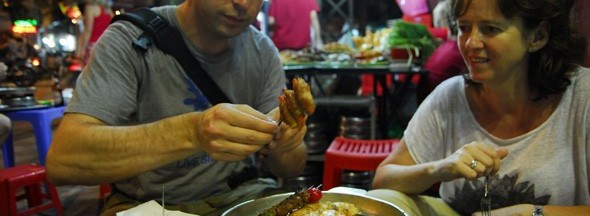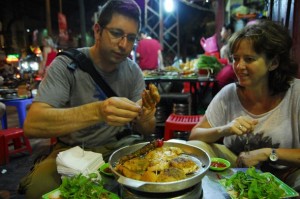While Vietnam is rich in history and culture, it also has an interesting cuisine, probably one of the best in the world. It takes pride in its fresh, healthy ingredients and varied, deep flavours. There are restaurants, markets, street vendors and food stalls in almost, if not all, corners of every city, undeniable proof that food is one of the most important lifebloods of the Country.
Whatever meal is served though, there is sure to be nuoc mam, a fermented fish sauce which is considered the king of all condiments in Vietnam. When it comes to the most basic Vietnam dish, Pho is regarded as the country’s national food. It is originally a Northern specialty which comes in two varieties, pho ga (chicken) and pho bo (beef).
Pho is soup which consists of thin and flat rice noodles as the base. The broth is made of slowly simmered beef or chicken bones, charred onion, and spices such as star anise and ginger, poured on top. The meal is then garnished with thinly sliced white onions, basil, lime juice, fresh chili, bean sprouts, and sauces like hoisin, fish and chili. Brisket and flank are the usual cuts of meat used, but for those daring enough, they can try stomach lining. Called pho tai sach, it has a chewy taste that may seem scary at first, but will feel delightful later on and in fact complement well with the broth.
Bun rieu is another good but slightly unknown Vietnamese soup made of fresh vermicelli noodles and sour crab-based broth. It can be served with either sautéed snails and crab (bun oc rieu cua) or with crab alone (bun rieu cua). Crab absorbs the sour flavour, while snails enhance the smell and texture of the dish. Red tomatoes can also be added for a touch of tanginess to the whole dish. Finally, some lime wedges, bean sprouts, herbs, green vegetables and mam ruoc (fermented shrimp paste) are available for diners to add a personalized finishing touch to their meal.
Cha gio and Goi cuon are the most ideal supplements. Cha gio or Imperial Rolls, is Vietnam’s version of the classic Chinese egg roll. It is stuffed with seasoned ground pork mixed with shrimp or crab, wood ear mushrooms, and sometimes shredded taro root. The rolls are wrapped in thin rice paper and then deep-fried until they turn very crispy. They can be eaten as they are or wrapped in Romaine lettuce and dipped in nuoc cham (fish sauce with lime juice, garlic and chilli). Goi cuon on the other hand is fresh spring rolls filled with slices of boiled pork and shrimp, lettuce, herbs and then dipped in either hoisin and peanut sauce or fermented fish sauce. It’s a very light dish recommended for people who want great taste minus the guilt.
Most of Vietnamese cuisine originated in Hue City, former imperial capital of the country, specifically in Saigon. Bun bo Hue is one of the most famous delicacies in the area, and it differs from pho and bun rieu in that instead of the usual flat and thin rice noodles, it uses cylindrical and thick noodles. Its taste is also a little spicy and its broth is made of beef and infused with lemongrass. The dish also includes thin slices of tender beef shank, pig’s knuckles, bean sprouts, lime wedges, shrimp paste and thin slices of banana blossom. Some versions add in cubes of congealed pig’s blood for more depth in flavour.
Com hen is another Hue specialty, a spicy rice dish with toppings of clam, peanuts, sesame seeds, crispy noodles, basil, pork rinds and herbs. It is accompanied with a broth made of clam for an overall subtle yet gratifying taste.
Mi quang is a must-try in Da Nang City with its unique dry noodles and mild, orange broth that is both sweet and spicy. The noodles resemble fettuccine, wide and yellow because of the addition of turmeric or saffron. It is best accompanied with banh trang (sesame rice crackers), scallions and toasted peanuts for a balance in taste and texture. It is also served with herbs and green vegetables like most Vietnamese noodle soup dishes.
For appetizers or light snacks, banh beo, banh nam and banh bot loc are the top choices because they are served in small portions just enough to satisfy one’s palate without the heavy feel of a regular meal. Banh beo for example is steamed rice flour cake topped with scallion oil, mung bean paste, minced shrimp and crispy rendered pork fat. It comes along with a sauce made of sweetened fish. Overall, it is a soft cake served either individually on a porcelain dish or layered on a plate.
Banh nam is a flat and rectangular rice cake filled with minced shrimp and scallions, steamed in banana leaves and accompanied by salty fish sauce. The leaves serve a dual purpose since its outer part is also used as a plate for eating the cake. Banh bot loc is a clear, gelatin-like cake embedded with sautéed shrimp and sliced pork belly. It is made from tapioca flour and can either be steamed (wrapped in banana leaves) or boiled. It is best served with scallion oil, rendered pork fat and fish sauce.
Banh xeo is Vietnam’s take on the famous crepe. But it differs from the typical recipe of the South in that instead of using big and very thin crepes, its version is mustard leaves wrapper filled with grilled pork pieces, bean sprouts and whole mung beans. It is then fried over big flames using a small, flat iron plate and dipped in nuoc cham.
Che thap cam is the region’s famous dessert made of beans, jellies, tapiocas, coconut milk and shaved ice and served in a glass.
Vietnamese food is also characterized with subtle addition of herbs and seasonal ingredients. Spicy and sweet are just some of the notable tastes in an array of other distinct flavours. And while its portions are smaller compared to servings in other places, the guarantee of fresh ingredients, strong yet heavenly taste, and overall unique flavour makes it a cut above most cuisines, truly deserving of its title “gastronomic paradise.”

